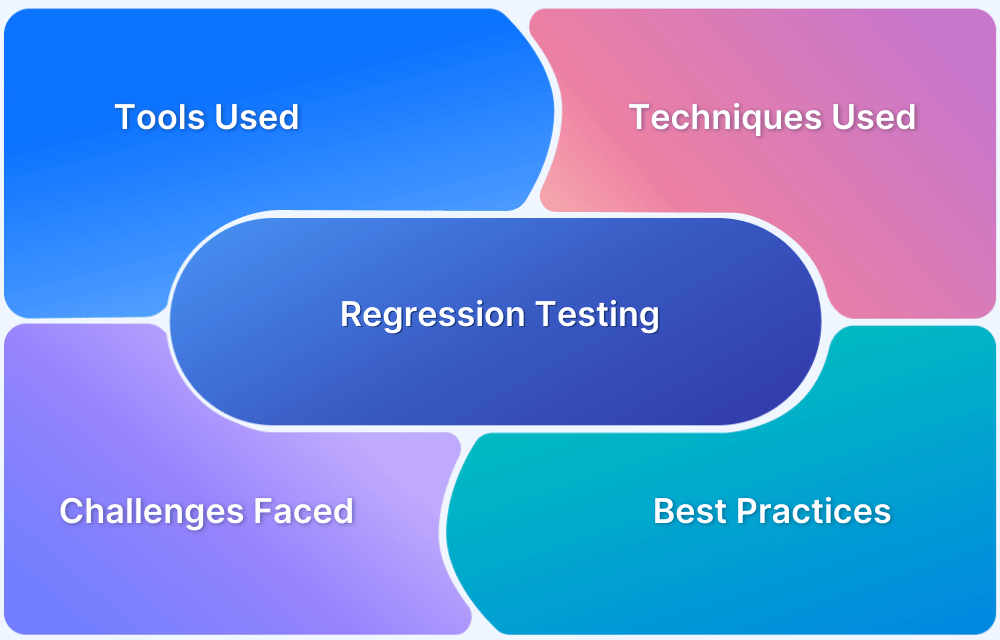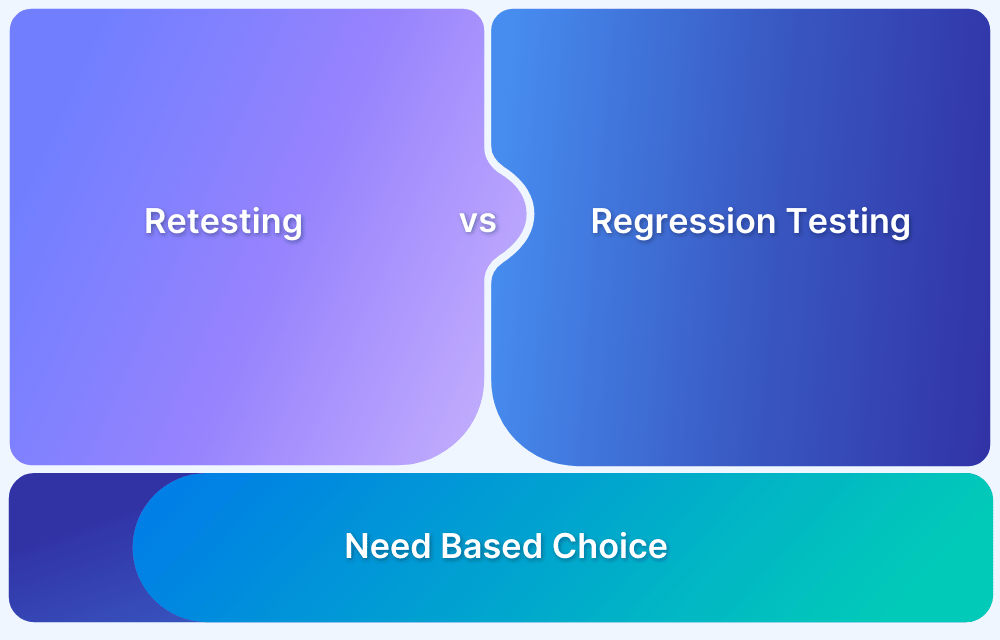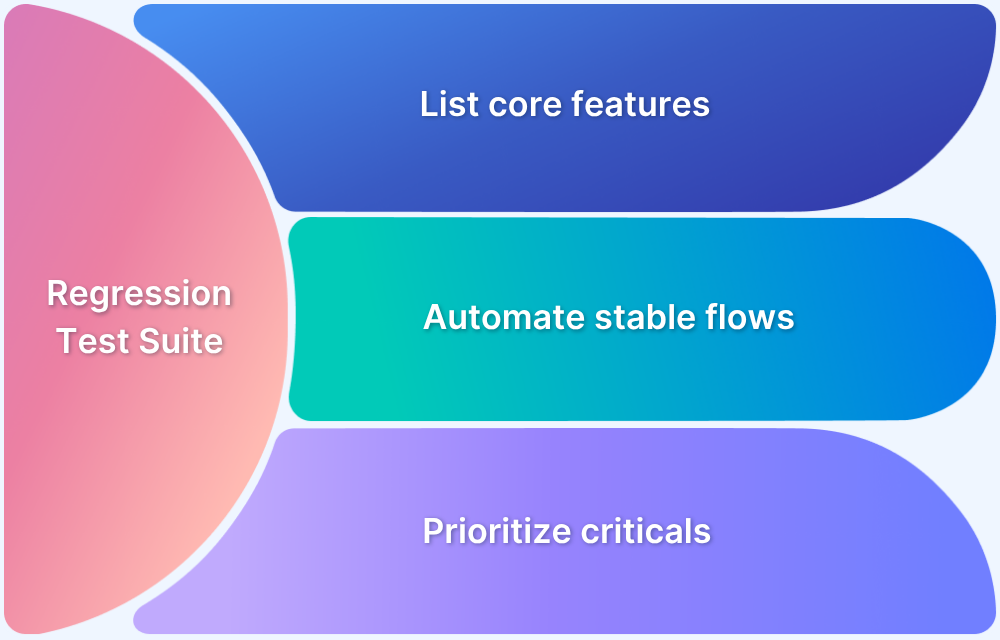Regression testing helps ensure that new changes do not break or degrade the behavior of already working features. A Regression Test Plan helps keep this process organized and ensures it is thorough, repeatable, and aligned with the team’s testing goals.
Overview
What is a Regression Test Plan?
A Regression Test Plan is a document that guides the testing team through the regression testing process. It describes what areas of the application will be tested, which test cases will be used, what resources are required, and when and how the testing will be performed.
What to Include in a Regression Test Plan?
A well‑prepared Regression Test Plan provides a roadmap for effectively managing testing efforts. It typically includes:
- Scope of Testing: Defines which areas, features, or modules will be tested.
- Test Cases to be Run: Lists the test cases selected for regression testing.
- Environment Details: Describes the hardware, software, and network settings required.
- Test Schedule: Provides timelines for planning, execution, and reporting.
- Roles and Responsibilities: Identifies team members and their responsibilities.
- Entry and Exit Criteria: Defines the conditions required to start and end the regression testing phase.
This article explains what a Regression Test Plan is, what it should include, how often you should run regression tests, and the steps to carry them out effectively.
What is Regression Testing? (with Example)
Regression testing is the process of re-running previously executed test cases to confirm that recent changes or updates have not introduced new defects or broken existing features. It is done after code changes, bug fixes, or feature additions.
For example, if an online shopping site adds a new “Wish List” feature, regression testing ensures that the existing “Add to Cart” and “Check Out” features still work as expected. Similarly, if a project management app adds a new ‘due date’ field for tasks, regression testing verifies that viewing, editing, and filtering tasks still work correctly.
Purpose and Scope of a Regression Test Plan
The purpose of a regression test plan is to define a structured approach for verifying that changes in the application do not negatively affect existing behavior. Its scope covers selecting test areas, prioritizing test cases, setting execution frequency, and identifying required environments and data.
Objectives of the Regression Test Plan
The objectives of the regression test plan define the key results it aims to achieve, ensuring the application remains stable and reliable throughout its lifecycle.
- Validate Changes: Confirm that recent code changes have not introduced new defects or broken existing features.
- Ensure Stability: Maintain the overall quality and performance of the application across releases.
Read More: How to set goals for Software Quality
- Early Detection: Quickly spot unexpected behavior introduced by new changes, reducing defect leakage.
- Support Continuous Delivery: Enable seamless and confident deployment by verifying core features every time.
Read More: What is Continuous Delivery in Devops?
What to Include in a Regression Test Plan?
After you have understood the purpose of your regression plan, along with the assumptions and dependencies of the plan, you must go ahead with creating your test plan.
The following list describes elements of a successful regression test plan:
- Test Cases: Define the test cases to be executed during the regression testing. These test cases should cover all the system functionalities based on the test scenarios and requirements.
- Test Environment: Identify the hardware and software configurations required to run the regression tests, including the version of the app being tested, OS, database, and any other dependencies.
- Test Data: Test data should cover all the possible scenarios and be consistent across all test cases.
- Test Execution: Define the test execution schedule and the regression test timeline. This should include the resources required, such as personnel, hardware, and software.
- Defect Management: Establish the process for reporting, tracking, and managing defects found during regression testing. This process should include the severity of the defects and the priority of the defects.
- Risk Analysis: Identify the risks associated with the regression testing and establish a mitigation plan to manage these risks.
- Test Sign-off: Define the criteria for test sign-off and approval, including the metrics and results needed to consider the regression testing successful.
- Documentation: Prepare the necessary documentation, including test cases, test data, results, and defect reports.
Prioritizing and Selecting Regression Test Cases
Prioritizing and selecting test cases ensures that you focus on the areas that matter most when verifying changes. This approach helps balance risk, coverage, and effort, ensuring critical defects are caught early.
- Impacted features: Choose test cases for areas that have been changed, added to, or fixed recently. These have the highest risk of introducing new bugs.
- High‑risk areas: Focus on areas that have caused serious bugs in the past or have a significant impact on revenue, user experience, or compliance.
- Frequently used user paths: Test core user flows like login, payments, search, or sign‑ups first. These are used by most customers and must work properly.
Also Read: Payment Gateway Test: A Complete Guide
- Integrated or connected modules: Cover test cases where changes in one area can affect another as complex connections often lead to unexpected issues.
- Time‑sensitive scenarios: Run test cases that quickly reveal critical failures early in the test cycle. This allows faster feedback and quick fixes.
- Maintain balance: Regularly review priorities based on recent production issues, user behavior and new feature rollouts to keep the test suite aligned with risk and business needs.
Manual vs Automated Regression Testing
A regression test plan often includes both manual and automated testing. Manual testing is ideal for complex or new features, while automated testing is suited for stable and repetitive test scenarios. Combining both approaches allows teams to cover critical areas efficiently and reliably.
Here is a table that compares manual and automated regression testing:
| Aspect | Manual Testing | Automated Testing |
|---|---|---|
| Best For | New, complex or rarely changed features | Frequently used or stable test scenarios |
| Execution Time | Slower, depends on tester availability | Faster, can run multiple times with minimal effort |
| Maintenance | Minimal for test cases, higher effort per run | Higher effort upfront, low effort for repeated runs |
| Cost and Skills | Requires experienced testers for review and execution | Requires coding knowledge and test automation expertise |
| Ideal Use Cases | Exploratory testing, one‑off scenarios, usability review | Regression test plan for routine test cycles, CI pipelines and core features |
| Main Advantage | Human judgment finds unexpected issues | Speed and precision reduce risk across long‑running projects |
How Frequently to Perform Regression Testing
Run regression tests every time you add a new feature or fix a bug to ensure existing features work as expected. As the software grows, it’s also essential to run a full regression test before major releases and at the end of every sprint to maintain overall stability.
In a CI environment, you can then use a smaller, automated regression suite with every build so that issues are caught early and the software stays reliable throughout the process.
Common Challenges in Regression Testing
Regression testing sounds simple in theory, but in reality, it becomes a bottleneck as software grows and changes. Understanding these challenges is key to making it efficient and effective.
- Growing test suite: As features evolve, the number of test cases increases sharply. Without regular review, the test suite grows too large, becomes slow, and takes more effort to run.
Read More: How to Prepare a Regression Test Suite
- Identifying impacted areas: Changes in one part of the code can break features elsewhere, and it’s not always clear which test cases to run. Without a clear link between requirements, code, and test cases, critical areas can be overlooked.
- Managing flakiness: Environmental instability and fragile test data cause tests to fail intermittently for non-functional reasons. These flaky test results delay feedback and undermine the team’s confidence in the test suite.
Read More: How to avoid Flaky Tests?
- Maintaining environment parity: Maintaining environmental consistency becomes increasingly complex as infrastructure evolves. And these discrepancies often mask defects or create false positives.
- Managing test data: Complex datasets and privacy requirements complicate test data creation and maintenance. Without robust data management strategies, testing cycles extend, and defects may escape detection.
Best Practices for Regression Testing
The goal of regression testing is to cover the right areas quickly, adapt as the application changes, and build trust in every release. Here are some regression testing best practices.
- Maintain a core test suite: Keep a focused, well‑curated set of test cases that cover critical user flows and high‑risk areas and update it regularly as the application evolves.
- Prioritize wisely: Focus first on impacted areas and core flows when changes are introduced. Then, expand to other areas based on risk and usage.
- Balance automation and manual testing: Use automation for repetitive, stable and high‑impact test cases that must run frequently. Use manual testing for complex, or highly dynamic areas.
Read More: Manual Testing vs Automation Testing
- Integrate into CI pipelines: Make regression testing a seamless part of the build and deployment process. Faster feedback allows teams to spot and fix issues before they spread.
- Monitor test results and flakiness: Regularly review test results for reliability. Fix or remove flaky test cases so the suite stays trustworthy and actionable.
- Maintain test data and environments: Ensure test data reflects real‑world scenarios and environments match production closely. This reduces false positives and missed defects.
Also Read: Top 15 Test Data Management Tools
How to Run Regression Tests on BrowserStack?
A critical part of the test environment is the number of devices and platforms where your application runs. Testing your application on varied devices and platforms ensures that the user experience of your apps is seamless irrespective of where it runs.
Using BrowserStack gives teams access to a Real Device Cloud. Here are brief steps to go about regression testing:
1. Set up the Testing Environment: Once you sign up for a BrowserStack account, set up the testing environment. Choose the desired combination of browsers-OSdevices on which you want to run the regression tests.
2. Write Test Scripts: Next, you need to write test scripts that cover all the features and functionalities of the software application. You can write the test scripts using any popular automation testing framework, such as Selenium, Cypress, or Appium.
3. BrowserStack Integration: To run the test scripts on BrowserStack, configure the integration of your preferred test automation framework.
4. Run Regression Tests: Once the integration is configured, you can run the regression tests on BrowserStack by executing the test scripts. Access a real-time testing dashboard to monitor the test execution progress and view the test results.
5. Debugging: If any issues are found during regression testing, debug the test scripts using the tools provided by the testing framework or use screenshots, videos, or logs of the test execution to analyze the issues.
6. Generate Reports: After the regression tests are completed, you can generate reports that provide detailed information about the test execution, including test results, test coverage, and defects found during the testing.
Conclusion
Regression testing verifies that recent code changes do not cause failures in existing functionality. An effective regression test plan targets high-risk areas and balances manual and automated testing to maximize coverage and efficiency.
BrowserStack supports regression testing by providing access to a cloud-based real device and browser farm. It enables parallel test execution to speed up test cycles, integrates seamlessly with CI/CD pipelines, and offers detailed logs and screenshots to help debug regression failures quickly.







